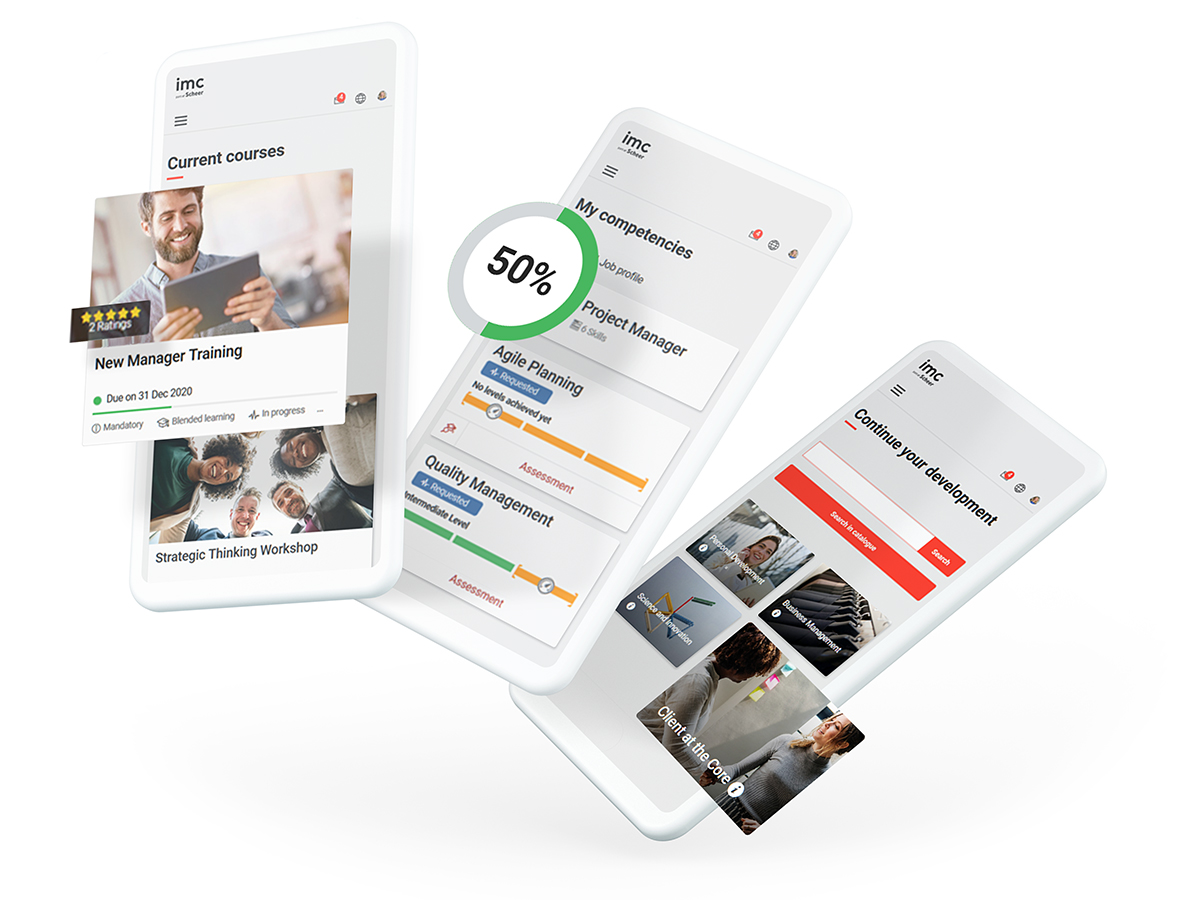
LMS Rollouts: Theory vs. Practice
A practical guide to implementing new learning platforms
Things often sound far simpler in theory than they are in practice. Checklists hold out the promise of smooth implementation processes, but more often than not they’re all theory and no practice. That’s why our guide to learning management system (LMS) rollouts is more than just a checklist. Its theoretical recommendations are supported by practical examples from our customers.

1. Analysis of requirements and objectives
Before selecting a learning platform, it’s important to analyse the company’s specific requirements and objectives. What are the skills that need to be developed? Which trainings are required? What learning methods will be most effective for the company’s employees?
Answering these questions carefully is an essential first step in finding a tailored learning platform that meets the company’s requirements.
Practical example: The REWE story
Once the REWE Group had decided to acquire a new learning platform, it set up several analysis working groups. It made a point of involving all stakeholders – everyone from IT to the works council, as well as all retail subsidiaries. Together, the working groups developed somewhere between 400 and 500 use cases with precisely defined processes and access privileges.
2. Selecting the provider and the learning platform
There are many learning platforms on the market. The key, therefore, is to select the one that best meets the company’s requirements. The chosen platform should be user-friendly and flexible. It must support a range of content types, including online learning courses, interactive modules and videos.
Practical tip: Meet your potential suppliers
REWE, STIHL, ALTANA and other imc customers recommend creating a catalogue of requirements and meeting with a shortlist of providers. Whether you call for tenders or approach specific providers directly, it’s important to focus on personal fit as well as the technical requirements. A new LMS is a long-term investment, so the relationship needs to work at both the interpersonal and technical level.

3. Employee training and awareness-raising, and LMS integration
Successful LMS implementation requires active workforce involvement and buy-in. It is therefore advisable to run training courses and awareness measures prior to implementation. This will focus learners on the benefits of the learning platform and familiarise them with its functions. Clear communication on the benefits and objectives of the platform is key to fostering a positive attitude.
Moreover, the learning platform should be implemented stepwise so as to ensure smooth integration. Key steps here include providing comprehensive guidance for the employees, creating learning groups and forums for collaboration, and integrating the platform into the company’s existing systems and processes.
Best practice case study: Effective LMS implementation on the menu at DoN
Austrian catering and restaurant company DoN can teach us a lot here. Implementing an LMS in a way that enables employees to be more effective hinges on ensuring that the employees understand why they have to change the way they work.
DoN’s answer was to create learning content, tutorials and the like in the lead-up to its LMS rollout. It did this using the imc Express authoring tool. The resulting content was then progressively released to its employees so as to build up their interest in the LMS.
Alongside this, DoN held town hall meetings with its employees. It also handed out DoN-branded “stress heart” key rings with QR codes linked to a fun quiz about the company. Result: the employees were very positive about the new system from the outset because they already understood its functions and purpose.

4. Performance measurement and feedback
It’s essential to regularly monitor and measure the learning platform’s effectiveness. This can be done through feedback, performance indicators and assessments of learning outcomes. The company must be prepared to act on this information and make adjustments to continuously improve its platform.
Practical example: Masterful learning at Jägermeister
A new system that is neither used nor optimised post implementation costs both money and employee goodwill. That’s why Jägermeister undertook platform tests with individual user groups right from day one.
It tested both the LMS itself and the groups’ individual learning content. This dedicated feedback is vital to Jägermeister’s ability to continuously develop and refine its LMS.

5. Ongoing development
A successful learning platform implementation is not a one-off project. It is an ongoing process. Companies need to invest in the ongoing development of their learning platforms. Only then can they be sure that their platforms are keeping pace with changing needs and technologies.
That’s a fairly self-explanatory point that probably needs no examples. But it’s worth emphasising that all LMS systems – including established ones – need dedicated staff to administer them.
Ideally that should be on a full-time basis, since in the vast majority of cases, it is not feasible to administer an LMS “on the side”. This is because admins themselves need regular professional development. And there is always work to be done setting up new courses and learning paths, etc.
Summary
Implementing an LMS requires effective project management and the commitment of all key stakeholders. If the new system is embraced as an opportunity to break with outmoded structures and is used as part of dedicated change management, it can be transformational for the entire organisation.
Still have questions about LMS implementation? Keen to talk to our experts? Drop us a line!

Diary of an LMS
If an LMS wrote a diary - what would it say?
We thought about that and share some tips for LMS professionals, told a little differently...

Informal learning: Everyday hero of work
“Formal learning is like riding a bus. Informal learning is more like cycling.” We explain what this means and share some key facts and recomemndations

More about our LMS
If you would like to learn more about imc's Learning Management, check here for more information.

Contact person
I have been working in the Marketing & Communication Team at imc since March 2019.
Communication, creative content and social media are my passion. "KISS - Keep it short and simple" is my credo.
To explain complex content in an understandable way and thus make the topic of e-Learning accessible to everyone is an exciting challenge every day.
Privately I love to read, play poker and travel a lot.
I am always happy to receive feedback or suggestions.

Navigating Change: the Importance of Future Skills
Strategic skills development for companies and individuals in a dynamic working world
What skills does a company need in order to remain successful and improve its ability to respond effectively in a constantly changing world? If we could answer this question with a definitive list, the discussion surrounding “future skills” would be very short.
But, alas, it’s not that simple. There is no universally definitive answer. We can, at most speak only in approximate terms. And therein lies the challenge.
The world of work is in constant flux, shaped by technological advances, changing expectations and ever-new business models. Faced with this highly dynamic and uncertain environment, companies need to get future-ready to ensure they remain successful. And central to this are future skills. These are skills that employees and teams require in order to remain actively in control in a constantly changing world. Our experts advise companies and organisations on how to approach this complex topic.

Uwe Hofschröer, Head of Learning Strategy Consulting at imc
Uwe Hofschröer and his team advise companies at the strategic level on learning objectives, learning formats, and learning content. “There are two layers of uncertainty on this subject,” he says. “Firstly, future skills are, by definition, dynamic. They relate to something that won’t become relevant until some point in the future. And secondly, they describe ‘supra-disciplinary skills’ that don’t relate to any current tasks or challenges affecting employees right now. But that’s not a reason not to engage with the subject.”
Self-directed learning and self-organised learning processes
Companies must take care not to confine their focus on future skills purely to the strategic level. They must follow the matter through to the individual level,
because skills are something developed by and in individual employees. Hence, the focus is on the individual’s ability to successfully navigate change. And that’s something that can be acquired only through overcoming real challenges.
Setting employees “future skills” as a learning task and providing them resources is not enough.
This is especially so since “future skills” transcend subject expertise. They are about enabling employees to navigate new, previously unknown challenges with confidence. They include communication skills, teamwork, critical thinking, and problem-solving skills. They also involve leadership in uncertain situations and the ability to engage successfully with new technologies.
To ensure employees can navigate future challenges in a self-directed manner, the learning process itself should instill self-organised learning as a core value.
Self-organised learning processes do, however, require a clear framework and must be aligned with the company’s strategy, objectives, and challenges. As Hofschröer explains: “In our experience, dealing effectively with the uncertainties surrounding future skills requires an interplay between the ‘company’ level and the ‘individual’ level.” In his view, there are three core aspects to this:

Defining goals and visions based on the company’s own corporate strategy, on market analyses, and on the specific environment in which the company operates. The key is not to treat future skills as a one-off, top-down project but to give employees an active role.

Reflection and operationalisation: Teams and leadership personnel have a key role to play in the development of future skills. Why? Because they are in a position to articulate the challenges in their work clearly and in detail. How? By organising learning processes to deal with their specific challenges. The company can support them with workshops on learning potential, coaching programmes, or training in methodologies like action mapping.

Building up capacity and integrating future skills into learning offerings: A one-off, standardised solution won’t do, because skills are acquired by individuals and are therefore highly dynamic. The company therefore needs to enable skill development in an integrated manner – in various learning environments and at different levels. This allows employees to develop skills in a way that matches their specific needs and learning situations.
Learning strategies and awareness campaigns as key components
The starting point should be a comprehensive awareness campaign. The aim here is to communicate the importance of future skills and strengthen the strategic framework for their development. It’s vital to get the team leaders on board here. It’s important to recruit them as multipliers and give them the tools they need to foster future skills in their teams.
At the learning strategy level, companies can define targeted formats and methods that integrate future skills into existing and new learning programmes. The formats and methods should foster self-organised learning, data literacy, creative problem solving, and social cooperation. This can, for example, be achieved in product training courses and onboarding programmes by using group work and projects.
The results are blended learning scenarios that promote self-directed learning and employee collaboration. This involves providing clear guidelines and structures to increase the likelihood of success.

Having a long-term perspective is key
It’s crucial not to treat future skills as a one-off matter. Future skills are an ongoing process that must be embraced at both the company and the individual level. “Set it up right, and you’ll create a self-perpetuating cycle of learning,” Hofschröer says. Surveys, monitoring, and focus group interviews are the tools of choice here.
Learning analytics also has a lot to offer here. Learning management systems (LMS) are ideal as evaluation tools. They are very effective at pinpointing and closing learning gaps. And they facilitate feedback and control at the overall company level, ensuring that the defined vision is achieved.
Companies that follow this long-term, strategic approach are better equipped to manage the challenges of the constantly changing working world. Future skills are the key to having agency and responding effectively in a volatile, uncertain, complex, and ambiguous world. They are therefore an important focus of skills development for every organisation.

Summary
Companies today are faced with the fundamental question of how to prepare for an unpredictable future. The importance of skills that go beyond mere knowledge is growing. Skills are the sum total of real-world abilities that are acquired by mastering specific challenges. The term “future skills” addresses this by focusing on skills that enable individuals and organisations to deal effectively with change and uncertainty.
This approach is not new. It has its parallel in the long-standing discussion of overarching key competencies – skills instrumental to meeting needs at both the individual and societal level. “Future skills” is a more recent term. It picks up on this idea, focusing on the various requirements arising from current societal and technological changes. In an unpredictable and fast-changing world, the quest for skills that can unlock the future is of the utmost importance.

Employment trends
Employee-led L&D (Learning & Development) can be used to combat the recently identified trend of 'quiet quitting'. Get all the insights here.

Psychological Safety as Prerequisite for Learning Organisations
Psychological safety sounds like a fluffy feel-good topic: all employees should feel safe. But there's more to it than that. Psychological safety is a basic requirement for any organisation wanting to develop positively.

Contact person
I joined the imc newsroom team in 2021. As a journalist my heart beats for content and storytelling.
I’m excited to figure out how e-learing and digitization affect the future of work. My task is to create content to talk about and I’m always looking for trends.
Privately I love to travel and eat Tapas.
Topics: E-Learning Trends, Corporate Social Responsibility, Press and Influencer Relations

Quiet Quitting
Harness the power of employee-led L&D to combat 'quiet quitting'
The talent landscape is undergoing a seismic shift as organisations grapple with the aftermath of the Great Resignation. In an era where employee engagement has become the holy grail, we saw the emergence of quiet quitting. Coined by Brian Creely in 2022, the term relates to employees who only work to the job description. They don't go 'above and beyond', and won't put in even the slightest extra effort or time into their work above what's set out in the job spec.
Inspired by the shifting workplace attitudes and expectations post-pandemic, employees now favour remote and hybrid working. They're driven by a desire of greater work-life balance. A recent AT&T study found the hybrid work model is expected to grow from 42% in 2021 to 81% in 2024. Quiet quitting for many represents a disengagement from working life, and a drop in productivity and efficiency.
So how much of a problem is quiet quitting, and how can businesses address the trend?

Impact of quiet quitting on worker attitudes
To understand the post-pandemic trends in relation to training, we partnered with independent survey company Research Without Barriers. Finding out employee attitudes to training in 2023 gave us a clearer picture of the wider issue of employee disengagement in the workplace.
We surveyed 2,000 UK workers, split between 1,000 managers and 1,000 non-managerial employees. The surveyed managers have over 15 years of work experience and work in companies of more than 15 employees. The surveyed non-managerial employees have a maximum of three years of experience, and work in companies with more than 15 employees. The goal of these sample requirements was to give us better insight into the attitudes held at different levels of seniority. In the context of a rise in quiet quitting, the results were surprising – and promising.
Is 'quiet quitting' impacting wider employee engagement?
A common belief about quiet quitting is that employees are disengaging because they don't want to work hard or build careers. Our research actually suggests that there remains a strong desire for personal and professional growth among the UK workforce.
A staggering 86% of respondents expressed a willingness to stay longer with their employer – if the employer offers more L&D opportunities. Employees also aren't necessarily interested solely for what a company offers them. Almost all (94%) believed that the company would also benefit if they were given more training. In other words, workers are still willing and interested in engaging with their employers, supporting business goals, and building careers. But they are seeking fulfilment and a mutually beneficial relationship with their employer. This conclusion is reinforced by the social shifts we saw with the Great Resignation, where workers sought work that enhanced their lives.
Our findings underscore the pivotal role that learning & development plays in engaging employees. It provides them with fulfilling work lives – directly impacting their engagement with their roles and countering quiet quitting.
Managerial involvement in training
Managers play a crucial role in nurturing a culture of learning and development within their teams. The survey results revealed that 59% of managers recognise the importance of training in keeping employees engaged and motivated in their roles. In fact, 78% of managers also acknowledged that training had a positive impact on their own commitment and engagement. Generally, business leaders are aware that learning and development have a direct impact on employee engagement at all levels. Understanding this gives us a tool to address quiet quitting within an organisation – where employees are willing and able.

How to deliver employee-led L&D
Despite the awareness, many organisations are falling short in leveraging learning and development as a tool for employee engagement, retention and skills enhancement. Only 29% of managers actively involve employees in selecting and integrating training programmes for their professional development. And 42% of employees reported having no active involvement in training beyond participation. This suggests that many employers, while aware of the benefits of training, are missing out on the benefits that come from actively involving workers in their own development.
There are simple ways to harness the benefits of employee-driven learning and development. These include giving employees personal ownership of training through suggesting courses or subjects and assisting with the sourcing of learning content. But it may also extend to involving employees in learning KPIs or the development of learning pathways.
Russell Donders, Director of International Markets at imc Learning, notes that "we have worked closely with businesses to offer bespoke training and development pathways for a range of industries. Feedback from customers, and our research, is clear: training is a key contributor to employee engagement and business development. Each of us wants to fulfil our potential, and we see huge success in the businesses who understand how to implement that on a personal level.
Bespoke training packages, rolled out across all levels of operation, is a simple and effective tool to engage and retain talent. It even feeds into the recruitment process. In fact, 92 percent of job seekers now consider L&D opportunities to be a dealbreaker – so it makes sense this would also feed into engagement for existing talent. Empowering individual-driven learning and development pathways is a simple but effective solution to address changing priorities and reverse, or avoid, quiet quitting."
Quiet quitting can be addressed by employee-led L&D
Employee engagement has become of paramount importance given the challenges around talent scarcity. The trend of quiet quitting highlights the significance that employee satisfaction and fulfilment now play in modern-day workplaces. Businesses that are responsive to that will see real benefit to productivity and talent retention. By embracing employee-driven learning and development, organisations can align themselves with the evolving needs of their employees. The aim is to enhance retention rates and create a positive, growth-centred workplace in which productivity is a natural consequence of the environment.
Looking to implement an employee-led L&D programme?
We'd love to hear how your organisation aims to increase loyalty and engagement through employee-led L&D. Get in touch with us to see how imc can help you best reach your strategic goals.

imc board member Sven R. Becker talked to cybernews.com about competency-based learning
"Institutions must shift their focus from imparting pure factual knowledge to facilitating competency-based learning"

If your business is undergoing a digital transformation, you need to embrace not only cutting-edge technologies like VPNs, AI, and antivirus services, but also take comprehensive employee training very seriously.
As we all know, your people are the lifeblood of your business. Despite e-learning not being a new concept, many companies – from startups to large corporations – are now realizing the value of implementing a dedicated learning management system (LMS).
Sven R. Becker, Executive Board Member of imc, gave some insights into how a digital learning platform helps businesses train their employees more efficiently.
Read more on cybernews.com

automotive sector
Revolutionising automotive training with modern e-learning
The automotive industry is a rapidly evolving landscape. While new entrants to the market are relatively rare, fierce competition and rapid technological advancements create unique business and training challenges. Companies in this sector must ensure that their workforce is skilled and knowledgeable to stay ahead of the curve.

E-learning has emerged as the natural solution to help automotive companies streamline their training processes and gain competitive advantage. Having created automotive training solutions for several market-leading clients, we understand their environment.
Here we explore the advantages that great e-learning can bring to the table.
Unique business and training challenges in the automotive sector
- Technological advancements: The automotive industry is witnessing a paradigm shift, with the introduction of electric vehicles (EVs), autonomous driving systems, and connected cars. Global auto brands need to train their employees on new technologies and their applications.
- Regulatory compliance: Automotive companies must comply with strict safety and emissions regulations, which often vary across regions. Employees need to be aware of and adhere to these regulations.
- Skilled labour shortage: The automotive sector suffers from a skilled labour shortage, and auto companies are quickly upskilling their existing workforce to meet the demands of the market.
- High employee turnover: This industry often experiences high employee turnover rates, which means that companies must invest in consistent training for new hires and existing employees.
Why e-learning is the perfect solution for automotive companies
- Flexibility and scalability: E-learning platforms allow automotive companies to deliver training modules that learners can access anytime, anywhere. This flexibility ensures that employees can complete their training at their own pace, reducing the impact on their work schedule. Furthermore, L&D managers can easily scale e-learning to accommodate a growing workforce or the introduction of new technologies.
- Cost-effectiveness: Traditional training methods are expensive, with costs associated with travel, accommodations, and physical training materials. E-learning platforms significantly reduce these costs, making it a more affordable option for automotive companies.
- Personalisation: E-learning platforms can be customised to create personalised learning paths, catering to the individual needs of employees. This ensures that each employee receives training that is relevant to their job role and helps them fill their skill gaps.
- Consistency and compliance: E-learning platforms ensure that all employees receive the same training content, promoting consistency across the organisation. Moreover, administrators and training supervisors can quickly update courses to reflect changes in regulations. That way, they keep employees up to date with the latest compliance requirements.
- Analytics and performance tracking: The leading e-learning platforms, such as the imc Learning Suite, provide detailed analytics on employee performance. Automotive companies are able to track progress, identify areas that require improvement, and provide targeted support.
- Engaging and interactive content: E-learning platforms offer a variety of multimedia content, such as videos and quizzes, making the learning experience more engaging and enjoyable for employees. And easy-to-use e-learning authoring tools like imc Express empower your in-house subject matter experts to create engaging e-learning - without the need for design or technical experience
Automotive e-learning examples
How to get started
E-learning presents automotive companies with a powerful tool to address the unique business and training challenges they face. By leveraging the benefits of e-learning, automotive companies can stay ahead of the curve by continually upskilling their workforce, ensuring regulatory compliance, and fostering a culture of continuous learning.
Create an agile, knowledgeable workforce ready to tackle the challenges of the ever-evolving automotive industry.
Are you involved in L&D for an automotive company and want to learn more about how the best in modern e-learning can support your training? Get in touch, we'd love to hear from you!

the public sector
Public sector training - e-learning for government agencies
Government agencies, entrusted with serving the public and maximising budgets, must continually adapt to new policies, regulations, and technologies. A well-trained workforce is crucial to ensure that these agencies operate efficiently and effectively.
E-learning can be a powerful tool in helping government agencies overcome training challenges and deliver high-quality services to taxpayers. We've created innovative, impactful solutions for private and public sector training clients across the globe, so we understand the unique challenges faced by government bodies.
Here we look at how great e-learning can help address these challenges.
Unique training challenges in government Agencies
- Large and diverse workforce: Government agencies typically employ a large workforce with diverse roles and responsibilities. Consequently, public sector L&D departments can find it a challenge to deliver consistent and relevant training to such a varied audience.
- Budgetary constraints: Government agencies often operate within strict budgetary limits, making it difficult for them to invest in comprehensive training programs.
- Rapid policy and regulation changes: Government employees need to stay abreast of evolving policies, regulations, and procedures that govern their work. This requires regular and up-to-date training.
- Geographical dispersion: Government employees often works across vast geographical areas. Training managers sometimes find it difficult to coordinate and deliver in-person training.
- Security and privacy concerns: Government agencies must ensure that their training programmes comply with stringent security and privacy requirements to protect sensitive information.

Why e-learning is ideal for public sector training
- Cost-effectiveness: E-learning platforms can reduce the costs associated with traditional training methods, such as travel, accommodations, and printed materials. This allows government agencies to maximise their training budgets and reach a larger audience.
- Flexibility and scalability: E-learning provides government employees with the flexibility to access training materials anytime, anywhere. This enables employees to learn at their own pace and schedule, leading to higher engagement and completion rates. Additionally, e-learning platforms can be easily scaled to accommodate a growing workforce or the introduction of new policies and regulations.
- Personalisation: Customisable e-learning platforms let you deliver personalised learning paths tailored to the specific needs of each employee. This ensures that employees receive training relevant to their job roles and responsibilities, resulting in better performance and higher job satisfaction.
- Consistency and compliance: E-learning platforms ensure that all employees receive the same training content, fostering consistency across the organisation. Moreover, training managers can quickly update hem to reflect changes in policies and regulations, ensuring that employees stay current with the latest requirements.
- Analytics and performance tracking: The leading e-learning platforms, like our own imc Learning Suite, provide detailed analytics on employee performance, enabling government agencies to monitor progress, identify skill gaps, and provide targeted support.
- Enhanced security and privacy: E-learning platforms can be designed with robust security and privacy features to ensure compliance with government regulations and protect sensitive information.
Examples of successful public sector e-learning
How to get started
E-learning presents government agencies with an effective and efficient solution to address the unique training challenges they face. By embracing e-learning, government agencies can empower their workforce with the skills and knowledge needed to deliver high-quality services.
The result is a more agile, well-informed, and efficient public sector.
Are you involved in national or local government L&D and want to learn more about how the best in modern e-learning can support your training? Get in touch - we'd love to hear from you!

workforce
Training diverse and disparate workforces
Here at imc Learning, we have decades of experience helping customers train hybrid workforces - diverse and disparate learners at global companies. In this post, we cover some of the essential tools and strategies for L&D leaders to consider when training a hybrid workforce.
We also look at how the best e-learning solutions make creating, delivering and analysing your training easier than ever - wherever your employees are based, and whatever language they speak.

Look back a decade, and early proponents of remote work, such as Basecamp, were seen as unusual - even maverick. Today, post-Covid-19 pandemic, some level of remote or hybrid work is standard for large organisations.
What can vary considerably between large organisations though is the quality of training to hybrid or remote workers and the level to which they are kept engaged and in the loop.
Checklist for training hybrid/remote workers
Many of the points here might seem obvious, but whether you are an experienced L&D leader or relatively new to training remote teams, it can be easy to see certain elements of employee engagement as a given and forget to carry them out. Unfortunately, out of sight can really be out of mind all too often, and this can lead to a feeling of isolation and disengagement among remote workers.
Below is a checklist to help you ensure you don’t miss out any of the steps needed to create a comprehensive training programme for your hybrid workforce
Assess your training needs
Before you can create a training program, you need to understand your unique needs. Consider the following to train your hybrid workforce:
- Job roles: Identify the skills and knowledge required for each job role.
- Skill gaps: Determine the skills that need improvement or development.
- Technical requirements: Evaluate the tools and technology needed to support remote and onsite employees.
Set clear objectives and goals
Establish specific, measurable, achievable, relevant, and time-bound (SMART) objectives for your training program. These objectives should align with your company's overall goals and focus on addressing the skill gaps identified earlier.
Choose the right training formats
To accommodate both remote and onsite employees, consider using a mix of training formats, such as:
- E-learning: Offer self-paced online courses and tutorials.
- Webinars: Conduct live or pre-recorded sessions for real-time interaction.
- Instructor-led training: Provide in-person or virtual classes led by experienced trainers.
- Blended learning: Combine multiple training formats for a more comprehensive learning experience.
Develop engaging training content
Create high-quality, engaging training content that caters to different learning styles. Ensure your materials are up-to-date and relevant to your employees' roles. Consider incorporating interactive elements like quizzes and gamification to boost engagement.
Leverage e-learning technology
Use various technology tools to support your training program, such as:
- Learning management systems (LMS): Use an LMS to organise, distribute, and track training progress. The imc Learning Suite integrates with many other HR and business software applications, and offers powerful training delivery and learner analytics tools.
- Video conferencing: Integrate video conferencing tools, such as Zoom, Google Meet or Microsoft Teams to facilitate virtual instructor-led training and webinars.
- Collaboration tools: Encourage teamwork and collaboration among remote and onsite employees through platforms like Slack or Microsoft Teams.
Implement a support system
- Mentorship programmes: Pair employees with experienced team members for guidance and support.
- Online forums: Create a space where employees can ask questions and share knowledge.
- Regular check-ins: Schedule periodic check-ins with employees to monitor progress and address any concerns.
- Peer-to-peer knowledge sharing. imc Express is an e-learning authoring tool that makes it easy for your subject matter experts to create and share engaging learning modules in as little as 10 minutes, with no design or coding expertise needed.
Evaluate and recalibrate your training programme
Regularly assess the effectiveness of your training programme by gathering feedback from employees and analysing performance metrics. Use this information to make any necessary adjustments to your training content, format, or delivery methods.
How to get started
Learning how to train a hybrid workforce requires a thoughtful and flexible approach. Often you will need to accommodate the needs of both remote and onsite employees. By following this checklist and leveraging the latest tech, you'll be able to create a comprehensive and effective training programme that supports the success of your entire workforce.
Would you like to discuss how our suite of e-learning solutions can support your hybrid workforce? Get in touch - we'd love to hear from you!

training for retail
Transforming retail training
with e-learning
The retail sector is a dynamic and rapidly changing environment. Advancing technologies, intense competition, and evolving consumer demands, all drive transformation. Training employees to stay ahead of these changes is critical to the success of any retailer.
For decades, we’ve helped some of the world’s biggest brands to maximise their retail training ROI. Here we look at the unique challenges faced by the retail sector and how great e-learning can help overcome these challenges.
Unique training challenges in the retail sector
- High employee turnover: The retail sector is notorious for high employee turnover rates. The average retail employee turnover is 60.5% in the US and 57.3% in the UK. This makes it essential for retailers to invest in training for new hires, but also to engage and retain your best existing employees.
- Seasonal workforce: Retailers often employ a large number of temporary or seasonal workers, who require quick and efficient training to perform their roles effectively.
- Diverse workforce: Retail employees come from various backgrounds and possess varying levels of skills and experience, making it challenging to develop and deliver consistent training that feels relevant to your learners.
- Dispersed workforce: Retail companies often operate across multiple locations, making it difficult to coordinate and deliver in-person training.
- Rapid technological advancements: The integration of new technologies, such as e-commerce, mobile payments, and inventory management systems, requires retailers to continually upskill their workforce.

Why e-learning is great for retailers
- Cost-Effectiveness: E-learning platforms can significantly reduce the costs associated with traditional training methods, such as travel, accommodation, and printed materials. This allows retailers to maximise their training budgets and allocate resources more effectively.
- Flexibility and Scalability: E-learning provides retail employees with the flexibility to access training materials anytime, anywhere. This enables employees to learn at their own pace and schedule, leading to higher engagement and completion rates. Furthermore, robust e-learning platforms can be easily scaled to accommodate a growing workforce or the introduction of new technologies.
- Personalisation: E-learning platforms can be customised to create personalised learning paths, catering to the individual needs of retail employees. This ensures that each employee receives training that is relevant to their job role and helps them fill their skill gaps. Such learning personalisation can help employees to feel valued and increase staff retention levels.
- Consistency and Compliance: E-learning platforms ensure that all employees receive the same training content, promoting consistency across the organisation. Moreover, they can be updated quickly to reflect changes in regulations or company policies, keeping employees up-to-date with the latest requirements.
- Analytics and Performance Tracking: The best e-learning platforms, such as the imc Learning Suite, provide detailed analytics on employee performance, enabling retailers to track progress, identify areas that require improvement, and provide targeted support.
- Engaging and Interactive Content: E-learning platforms offer a variety of multimedia content, such as videos, quizzes, and simulations, making the learning experience more engaging and enjoyable for retail employees. Easy to use e-learning authoring tools like imc Express can allow your own subject matter experts to create engaging e-learning as and when needed to share with colleagues - without the need for design or technical experience.
Retail e-learning examples
How to get started
E-learning presents retailers with a powerful tool to address the unique training challenges they face, such as fast-changing product lines and high employee turnover. By leveraging the benefits of modern e-learning, retailers can continually upskill their workforce, ensure training consistency, and foster a culture of continuous learning.
The result is an engaged, skilled, knowledgeable workforce that’s ready to tackle the challenges of a competitive retail landscape.
Are you involved in retail L&D and want to learn more about how the best in modern e-learning can support your training? Get in touch - we'd love to hear from you!

The Great Upskill
92% of workers favour an employer with the best L&D
The Great Resignation caused a major shift in personal and professional priorities among employees. Our recent industry survey identifies a new growing trend, 'The Great Upskill'. It emerges as the natural evolution of the Great Resignation, as people seek greater fulfilment in their working lives.
Aside from a greater expectation of flexibility, employees now want to work for employers that help them to enrich their working experience through ‘upskilling’, training, personal and professional development. Employers are responding by creating engaging career paths for the short, medium and long term. In return, a staggering 92% of workers favour an employer with the best L&D.
We wanted to find out more about this trend, and find out whether people are actually motivated to engage with training, and whether businesses are accommodating and using that motivator in an ever-changing workplace.
The absence of L&D drives employee disengagement
In response to The Great Upskill trend, we conducted research in partnership with independent survey company Research Without Barriers. Our aim was to investigate employee attitudes in relation to training. We selected our research demographic to obtain rounded insight from a cross-section of UK workers, primarily in office-based roles.
To this end we surveyed 2,000 UK workers, split between 1,000 managers and 1,000 non-managerial employees. The surveyed managers have over 15 years of work experience and work in companies of more than 15 employees. The surveyed non-managerial employees have a maximum of three years of experience, and work in companies with more than 15 employees. The goal of these sample requirements was to give us better insight into the attitudes held at different levels of seniority.
The Great Upskill is all about employees seeking greater fulfilment and engagement in their working lives. One of the key factors at pla is the pursuit of personal and professional development. While traditional workplace benefits relied on 'quick wins', such as team socials, employees now seek for greater meaning in their working lives. Our research found that 86% of employees would choose to stay with their employer for longer if they were offered frequent learning opportunities. This preference demonstrates that L&D is a major priority and motivator for employees and managers alike. Employers who understand this fact can benefit amid the Great Resignation and the rise of employee disengagement, i.e. 'quiet quitting'.
The findings show the impact of this trend on employee retention.

52% of employees left a role because of a lack of training
A staggering 52% of employees admitted that they had left a role due to the lack of development opportunities. This clear indicator shows that there is a practical and real-world impact of this trend. And HR departments are seeing impact extend to the recruitment process. In fact, 92% of workers surveyed reported that, if choosing between two potential employers, they would choose the employer who offered the best learning and development opportunities.
Our research also found that, despite the rising priority of training for workers, employers are not necessarily addressing this issue through frequent training. In fact, 48% of employees said they had not received training in the last 12 months. In addition, 22% of managers reported that they did not receive as much training as they would like.
Impact of L&D on employee engagement and business ROI
Our goal with this research project was to better understand the Great Upskill trend. It gives us our greatest insights yet into the attitudes that have developed in the workplace in the aftermath of furlough. These attitudes are what's behind the rise of remote working and shifting social attitudes.
Businesses may be tightening their belts due to recent economic uncertainty. But our research indicates that in terms of real-world impact, training is one of the most beneficial tools a business can utilise to safeguard their workforce and optimise employee engagement. As well as reducing employee turnover, training supports recruitment and increasing employee engagement. What's more, 81% of managers surveyed as part of our research project found that training had a positive impact on their business's bottom line.
The insights from our research are fascinating and demonstrate a clear social trend around The Great Upskill, and UK media agreed. We secured six news features relating to this research and trend, including in:
Want to foster a learning culture at your organisation?
Get in touch with us to talk about your L&D challenges, aims, and strategies – we'd love to hear from you!

Leadership Training: When the Boss Takes the Learner’s Seat
Improving leadership ability through effective training
Our perceptions and expectations of leadership personnel have changed a lot in recent years. Today’s managers are expected to have both subject expertise and good people skills. Subject expertise can be learned, obviously, but what about the people stuff – the soft skills?
Managers are expected to be able to see things from the employee’s perspective and respond appropriately. The requirements go far beyond merely delegating projects and issuing instructions. The usual hard skills need to be tempered with empathy and judgement in dealings with staff. And that’s where our experts can help – by designing leadership training courses.


Kathrin Heidler, Instructional Designer at imc
Kathrin Heidler has a degree in education, with a major in digital learning. Since 2020 she’s been an educational designer at imc, designing digital learning formats, blended learning strategies and web-based training courses. And she has a strong focus on leadership training. “For me, leadership means empathy for staff, backing your team – both internally and externally – and having technical expertise,” she says. “These are all things you can train for – the hard skills, obviously, but the social skills too. What I find exciting is to dive deep into the ‘how’ of that.”
“Leadership training” is not the same thing as “management training”
Heidler explains that at imc, leadership training means focusing on and learning the core competencies of effective leadership. It relates exclusively to non-technical skills, like communication, empathy, organisational and methodological competencies, and other soft skills.
Management training, on the other hand, relates to learning about new products, specific processes or strategies. It’s about acquiring knowledge and technical – or “hard” – skills.
Both types of training can be combined, of course, but they are generally intended for two different target groups:
- Employees new to leadership roles who need to learn the necessary people skills and understand their company’s mission.
- Employees already in leadership roles who need to learn new strategies or acquire new technical knowledge at the managerial level.

However, in both cases, the leaders concerned are generally time poor when it comes to learning. “Leadership personnel are always on a tight schedule, and time is always a big challenge for them,” Heider explains. “That’s why it’s vital to be efficient and find out in advance exactly who needs to do what training. This is especially true for management training courses.
In these cases, I like to work with our KPI-based Readiness Check. It allows me to gauge each learner’s existing knowledge level so that I can suggest appropriate content and learning options. That saves a lot of time and frustration.”
Success hinges on having clear parameters and expectations heading into these courses. “Both parties must have a realistic understanding of the basic requirements and constraints. And by both parties, I mean the company seeking leadership training, and us as their strategic partner,” Heidler explains. “What’s to be learned, and how? Realistically, how much time is available for the leadership training? Only by having clear objectives can we achieve successful training outcomes.”

“Effective course design is about getting from the aspirational to the factual”
Katrin Heidler has already supported numerous customers as a strategic sparring partner for the design of leadership training courses.
“Given all the hype around leadership and management training, I make a point of focusing the client on the basics,” she explains. “So, at the start, we stay very analytical and nail down things like exactly who the target group is. What defines the group? What is the learning objective? What specific actions and behaviours is the course supposed to teach?
“It’s not enough to simply say, I want to make the managers more agile. I have to be able to specify exactly what actions constitute agile behaviour. Breaking it down to specific actions enables the courses we design to achieve the desired outcome of better leadership ability.”
When designing leadership training, start by writing a list of core competencies and mapping those to specific types of action. This will provide clarity around what’s expected of the training because it provides a bridge from aspiration to facts and actions.
Choosing the right learning formats
Modular learning nuggets:
learners can complete a training session in just 10-15 minutes
Performance cards as digital flashcards:
Learning content can be presented in a short and punchy way
Virtual classrooms:
Time is blocked out directly in the learner’s calendar; this format does, however, require a trainer
Hot curriculum picks for leadership training
In closing, we asked Kathrin Heidler to give us her picks for learning objectives for leadership training in 2023:
“Leaders need to be aware that we’re in a time of economic and demographic change. And they need to be confident and sure – not fearful – in dealing with this change. They should continue to work on their own technical skills. Last but not least, they need to see their staff as people, with all the needs that being human entails. That would be my learning recommendation.”


Can Germany afford its current AI scepticism?
Artificial intelligence (AI) is often viewed sceptically in Germany, but often without justification. In this interview with Kristian Schalter, we talk about how future technologies will change our working world.

AI in Corporate Learning
There are many fears about the topic of artificial intelligence (AI). But especially in corporate learning, AI can be a great help.

Contact person
I joined the imc newsroom team in 2021. As a journalist my heart beats for content and storytelling.
I’m excited to figure out how e-learing and digitization affect the future of work. My task is to create content to talk about and I’m always looking for trends.
Privately I love to travel and eat Tapas.
Topics: E-Learning Trends, Corporate Social Responsibility, Press and Influencer Relations







